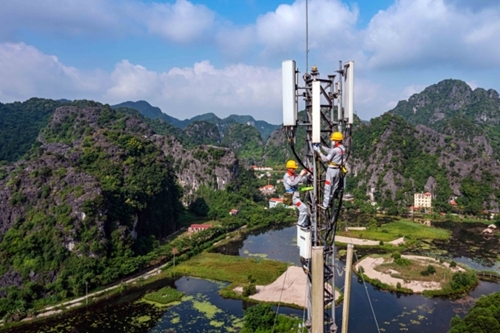To make calls, send messages or access the Internet, the phone you use is always connected to an invisible “wire” – the frequency. Such wire connects the phone to a nearby base transceiver station (BTS) which is connected to others and the main BTS, forming a network that transmits and receives data in the form of voice or short videos.
Therefore, network providers have paid due attention to investing in frequency to bring more experience to their customers.
In March this year, Viettel spent dozens of billions of VND to exploit frequency 2500-2600 Mhz for 5G network.
    |
 |
|
Viettel turns off 3G network to facilitate the expansion of bandwidth for 4G network. |
Best strategy for mobile network
Viettel has been the largest mobile network operator in Vietnam since 2008, with the number of BTSs doubling that of the second-ranked network operator. Its network has covered islands and border areas nationwide. In 2010 and 2017, Viettel continued to be the network operator with the largest 3G and 4G network deployment. As soon as 4G appeared, Viettel's network planners realized the problem that 3G consumed network resources and was unnecessary. Thus, they decided to turn it off. It completed the turning-off of 3G network in 2023 and becomes the only operator in Vietnam successfully turning off such network.
Nguyen Thi Tam, Deputy General Director of Viettel Networks, explained that 2G provides voice services and no data, while 4G provides data very efficiently and no voice. 3G is in the middle, providing both voice and data, but the data quality cannot be compared to 4G, while occupying a lot of bandwidth.
Viettel’s successful shutdown of 3G network facilitated the expansion of bandwidth for 4G network.
Efforts to turn off 2G network
According to Mrs. Tam, at the time of planning the 3G network shutdown, the voice coverage of 3G was smaller than that of 2G, and the data coverage of 3G was equivalent to that of 4G. Therefore, when 3G was turned off, voice service was still guaranteed and the 4G network only needed to be upgraded to cover further and ensure data capacity.
    |
 |
|
Viettel is trying its best to help users shift from 2G to 4G network. |
However, with the number of 2G only subscribers reaching millions of people, Viettel found it difficult to stop providing 2G devices by October 15 this year and completely turn off 2G network on September 15, 2026.
Viettel’s 2G network cover 99 percent of the nation’s population while its customers of 2G only services reached nearly 10 million people as of early this year, according to Nguyen Van Son, Director of Mobile Center under Viettel Telecom.
Therefore, shutdown of 2G network requires huge volume of work, but Viettel still exerts all-out efforts to realize it.
Targeting to build a superior mobile network
Tam shared that Viettel’s goal is that the number of people using its 4G network is equivalent to that of 2G. It targets to build over 7,000 BTSs this year, 1.5 fold of that in 2023. As of September this year, over 5,000 4G BTSs were installed, covering 95 percent of the nation’s population. Viettel’s 4G BTSs account for some 40% of the 4G BTSs in Vietnam.
    |
 |
|
Viettel is concentrating on building a superior mobile network. |
Director Son said that in this year only, Viettel has an addition of more than 4 million of 4G users in remote and mountainous areas.
According to the latest data collected by Umlaut on mobile users, Viettel continues to rank the first in network quality with 919 points in overall quality, some 60 points higher than the second place. Viettel's data speed measured through the speedtest system has increased by 15%.
Mrs. Tam said that when 2G network is turned off, Viettel can focus frequency resources on new technologies, and customers will have better mobile quality, data and access to digital services and the internet.
Translated by Chung Anh